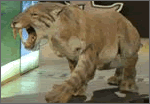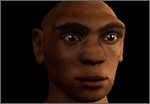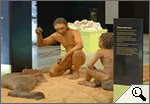|
|
|
 |
 |
 > A Temperate, Almost Tropical Climate > Hippopotamuses, Elephants, Sabre-Tooth Tigers... > Homo Antecessor, the First European dimarts, 17 de març de 2009
What was Europe like a million years ago? Was the weather good, or was it cold? Was there a lot of plant life? And was there a large of variety of animals? Were there humans, or had they even yet begun their long trek from Africa, the birthplace of mankind? The answer to these questions can be found at the exhibition 'Europe a Million Years Ago', now at the Museum of Archaeology of Catalonia in Barcelona, until 14 June.
The exhibition, which also explains the origins of life and the gradual formation of the continents as we know them today, is clearly educational, and includes re-creations of landscapes from that time, large-scale sets, sculptures, audiovisuals, etc. The exhibition also provides information about the scientific disciplines used by specialists (archaeobotany, archaeozoology and palaeontology) and some of the archaeological sites that have enabled them to reconstruct the Europe of a million years ago: Incarcal (Crespià, Pla de l'Estany), Vallparadís (Terrassa, Vallès Occidental), la Boella (la Canonja, Tarragonès), the Guadix-Baza basin (Granada) and Atapuerca (Burgos), which is the most important in the world in terms of the quantity, quality and variety of human fossils that have been found there. 'Europe a Million Years Ago' is organised by the Catalan Institute of Human Paleoecology and Social Evolution (IPHES), Rovira i Virgili University. A Temperate, Almost Tropical ClimateA million years ago, during the Early Pleistocene, Europe had a temperate, almost tropical climate. The Mediterranean area was more humid and considerably less arid than today. It was an interglacial period, i.e. between two glacial periods, meaning that flora and fauna were adapted to warm environments. The exhibition shows us how climatic variations, alternating between interglacial periods and glacial periods, brought about the extinction of some species and the appearance of new ones.
Hippopotamuses, Elephants, Sabre-Tooth Tigers...
+ Sabre-tooth tiger was the most feared predator.
Strange though it might seem, in those very distant times, there were trees such as olive trees, oaks, holm oaks, birches, beeches and walnut trees, along with animals that have endured until today: elephants, hippopotamuses, rhinoceroses, etc. (the ecosystem was very similar to that of the humid grasslands of current-day Africa). Europe was also home to hyenas, giant monkeys, lycaons (a genus of animals including African hunting dogs), large bovids, and equids similar to zebras. And let's not forget the most feared predator of all, the huge sabre-tooth tiger.
Homo Antecessor, the First European
+ Virtual recreation of Homo antecessor.
In 1994, after identifying human remains at Atapuerca, researchers believed that the genus Homo appeared in Europe 800,000 years ago. However, in 2007 the Atapuerca site yielded a 1.2 million-year-old Homo antecessor jawbone, the same species to which the other previously discovered human remains had been attributed. This exceptional find, which even made it to the cover of the prestigious British magazine Nature, meant that the appearance of humans in Europe had to be backdated by half a million years. The exhibition at the Museum of Archaeology of Catalonia includes a virtual recreation of Homo antecessor.
|
Investiga

> Animals de fa un milió d'anys.

> El descobriment de les restes humanes més antigues d'Europa: vídeo.
I també...
- Homo antecessor: reconstrucció en 3D.
- 'Europa fa un milió d'anys': entrevista radiofònica amb dos estudiosos de l'IPHES.
- Seus del Museu d'Arqueologia de Catalunya.
Portada |
Europa Press |
El Punt |
La premsa |
Especials |
Diari de l'escola |
LesFinances.info |
Editorials |
Mail obert |
Els blocs |
Lletres
Tecnologia i ciència | Solidaritat | Cap de 7mana | Campus | El 9 | Presència | Fòrums | Enquestes | Xat | Correu
Traductor | Edicions en Pdf | Wap-pda | Biblioteca | Lletra més grossa
Tecnologia i ciència | Solidaritat | Cap de 7mana | Campus | El 9 | Presència | Fòrums | Enquestes | Xat | Correu
Traductor | Edicions en Pdf | Wap-pda | Biblioteca | Lletra més grossa
| Què és VilaWeb? Publicitat Mapa web Contacte | Una web de Partal, Maresma i Associats, S.L. |




